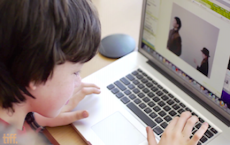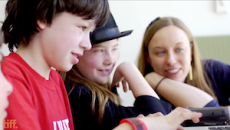 Mark Rabo recently led a Creative Jam as part of the TIFF Nexus New Media Literacies Conferences that took place in Toronto this spring. We asked him to share some tips for producers interested in collaborating with others in this innovative format that inspires creativity while harnessing the talents of its participants.
Mark Rabo recently led a Creative Jam as part of the TIFF Nexus New Media Literacies Conferences that took place in Toronto this spring. We asked him to share some tips for producers interested in collaborating with others in this innovative format that inspires creativity while harnessing the talents of its participants.
“Good artists steal”
“Everything is a remix”
“There is nothing new under the sun”
It’s both terrifying and liberating that the raw material of every idea has always existed. Terrifying because it leaves us no excuses, and liberating because it means we already have everything we need.
Philosophical ideas like this are often not practical in the real world but the embedded concepts of randomness, remixing, and unexpected outcomes are quite useful because they mean it’s only a matter of combining what exists—they remove the adult pressure to perform and replace it with a child’s lightness of play.
Creativity becomes about the existing, not the new; mixing not divining; mindfulness not inspiration; and randomness not perfection.
One great way to incorporate these concepts into our work is with the creative jam. I just finished leading one as part of the TIFF Nexus initiative and wanted to share some thoughts, experiences, and things I learned along the way.
If you’re not familiar with creative jams, they’re part networking, part prototyping, and very DIY.
A group of individuals or teams get together and in addition to generating ideas, they also generate prototypes. Another way to think of jams is “rapid prototyping for ideas” or “super brainstorming” where the goal is to go beyond the idea and make something in order to gain further insight and build momentum. Jams can take place over the course of an afternoon, a weekend or, as was the case with Nexus, several months.
Our was called the Youth New Media Literacy Jam (YNMLJ) and it brought together 20+ people from different industries to create projects around new media literacies for youth (ages 10-13).
Here are some things I learned over this three month long creative adventure.
Choosing Participants
In the spirit of unexpected outcomes, mix as many types of people as possible: different industries, temperaments, experiences, hobbies, etc. Bring together people who’d normally never cross paths — it’ll either be amazing or a disaster but always interesting. Also mix up ages; youths bring boundless energy and bravado and adults bring wisdom and experience.
Invite each person individually. Everyone can tell a mass email and no one feels important getting one. Instead, write a personal message and tell folks why you want them to participate. Tell them why you love their work or what they can contribute and how they’ll benefit. It takes a long time but people will appreciate the thoughtfulness.
Setting Expectations
Before choosing the final participants hold an info session. It’s a chance to meet everyone and tell them about the whys, hows, whens, and wheres of the jam in a no-commitment setting.
Never bait and switch. Be upfront with the commitment: “It’ll be three months and approx. 60hrs of your time to be part of this jam.” Make it sound painful. Marathons are tough but nobody whines that they’re too long. Be upfront and clear and you’ll get the most dedicated people.
Don’t pressure anyone to participate. Present your reasons for holding the jam and let people flow into it if they choose. Most people have busy lives and giving their time for free is a big ask—don’t force them. If anyone isn’t sure they can commit the time, tell them “No problem, I’ll count you out for the moment but if you change your mind let me know.” It removes any guilt and, more importantly, if they return you’ll know they’re fully committed.
Choosing Teams
We decided to choose teams rather than letting them self-organize. Some people knew each other and we wanted to encourage unexpected outcomes. Choosing teams is like choosing a puppy, you’re mostly going by gut. But I did have some rough guidelines in my head as I put them together
I tried to keep the overall energy in the team balanced: excitable people with stable, calm with explosive, makers with thinkers, etc. This yin-yang made teams more stable but also forced individuals to work with people very different from them. Again, hoping for unexpected outcomes.
I also tried to create interesting occupation/hobby pairings. What would happen if you mixed a musician with a sculptor? A tech-head with naturalist? A mathematician with a breakdancer? It could be a disaster but it could be amazing too!
Think Motivations
“Why should I give you 60 hours of my time for free?” This is what busy people are asking themselves. The answer depends on your project but you need to anticipate and address it. Here are some reasons for our jam:
You will:
- Meet good people — new friendships and collaborations are very important to motivated people.
- Grow your network — it can be hard to meet (let alone collaborate) with people from different industries.
- Explore new ideas — creative folks have stacks of ideas they want to explore, this could be a platform for that.
- Learn outside your field — curious people want to learn. We took teams on “Field Trips” where they learned about things helpful to their projects from experts (ie. a child psychologist explaining how the 10-13 year old brain works).
- Have fun — guys and girls just wanna…
- Eat lots — we had some great spreads of snacks at every meeting. I’m convinced this was directly tied to the successful end results.
To Prototype or Not To Prototype
This depends on the goals of your jam and how/where/to whom you’ll be presenting but I recommend at least entertaining the thought of NOT prototyping.
Prototyping is extremely time consuming and by definition unpolished. It’s difficult to provide the proper context for a prototype and they often come across unimpressive. We decided to encourage groups to focus on their idea rather building it. This sounds like I’m going against what I said earlier about jams being more than just ideas, but you don’t need to physically prototype to thoroughly explore an idea. Groups still dove deep but instead made videos, sketches, animations, diagrams, and websites – they still demonstrated their idea, just not in a hands-on way.
Not prototyping also allows participants to explore outside the confines of current technology which gets them really excited.
Avoid the Storage Room
So many great projects end up in dusty storage rooms the day after the presentation. To avoid this, we required (one of the few things we required) each team to create a website with a custom domain, a video, and business cards with the website address (we were presenting at a mixer where people were drinking and socializing so we wanted something they could put in their pocket and follow-up in soberer times.)
Not only did this allow the projects to live on, but also gave teams ownership and, as a result, some have continued working on them and even collaborating with people they met at the showcase.
Cost & Scalability
At its heart, a jam is people gathering and making so it’s scalable to any size. Despite being supported by large cultural institutions, our budget for the jam was extremely low (food was the biggest expense.) With free online tools; meeting spaces in schools, libraries, coffee shops, and peoples’ homes; and not prototyping, cost becomes a non-issue. The people and brains are most important and any budget can be creatively accommodated.
Time
The Youth New Media Literacy Jam took place over 3 months but a jam can be as long as you like. In the indie video game community (where I was introduced to the jamming format) they go anywhere from a few hours, to a weekend, to a week. Choose a time-frame that makes sense for your goals and go for it. If you’re not sure, err on the side of short.
No matter what your creative goals, a creative jam is great way to explore, experiment, and move forward without having all the information. Less talk More rock. I’ve never seen a jam that didn’t result in some new insight, idea, or path to follow. Jams also expose us to the randomness and serendipity of the world and can show us creative roads we didn’t know existed.
 Mark Rabo is co-founder of the largest indie games festival in Canada, Gamercamp, and its spin-off for kids Gamercamp Jr. He’s on the board of The Hand Eye Society and is advisor to several game-related initiatives including GameChangersTO. He is currently collaborating with Mozilla and others on the Toronto version of The Hive Learning Network. His personal site is markrabo.com and personal Twitter is @markrabo.
Mark Rabo is co-founder of the largest indie games festival in Canada, Gamercamp, and its spin-off for kids Gamercamp Jr. He’s on the board of The Hand Eye Society and is advisor to several game-related initiatives including GameChangersTO. He is currently collaborating with Mozilla and others on the Toronto version of The Hive Learning Network. His personal site is markrabo.com and personal Twitter is @markrabo.
See Mark’s post about the TIFF Nexus New Media Literacies Conference.
Photo from TIFF Nexus Creative Jam courtesy of Endless Films.



